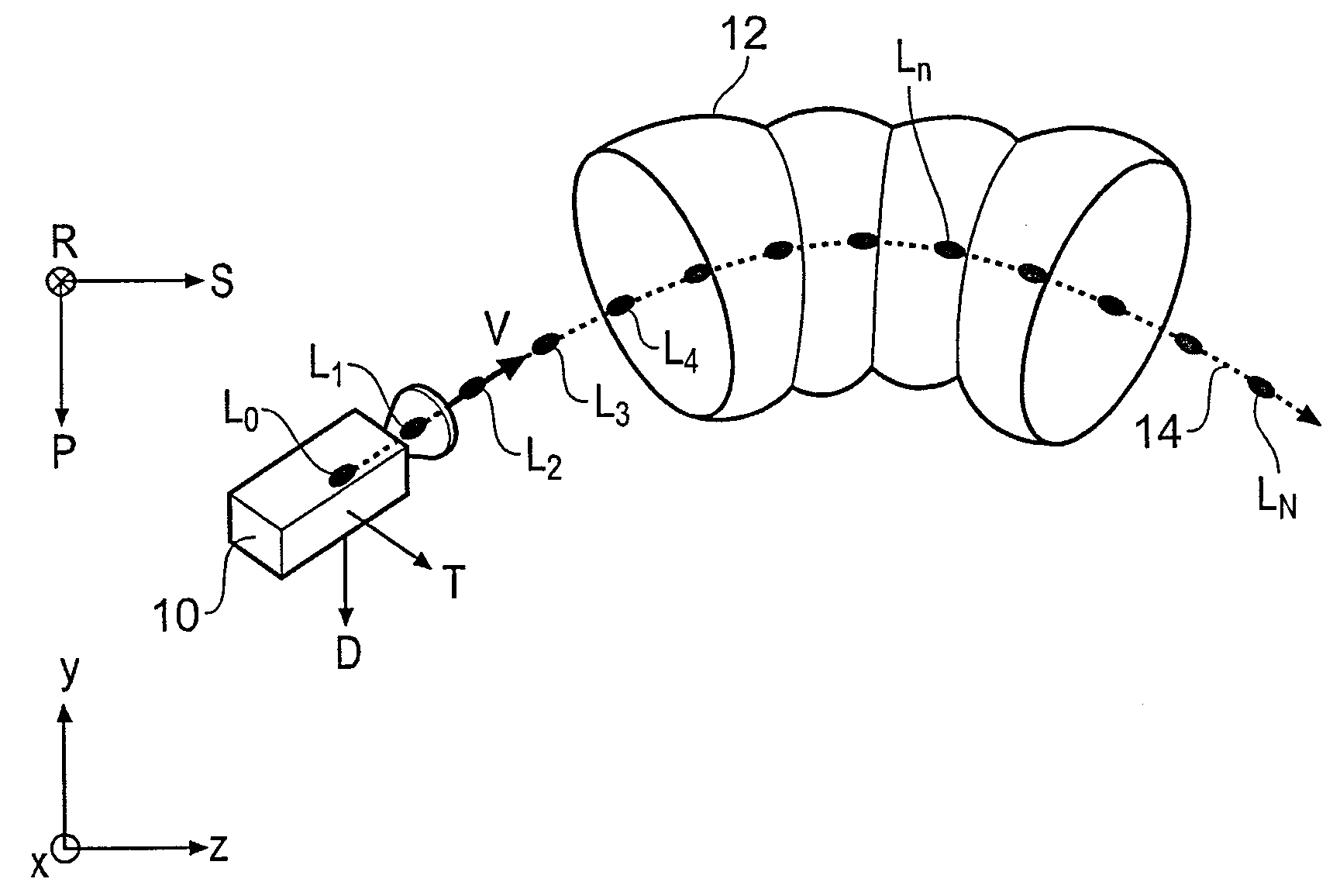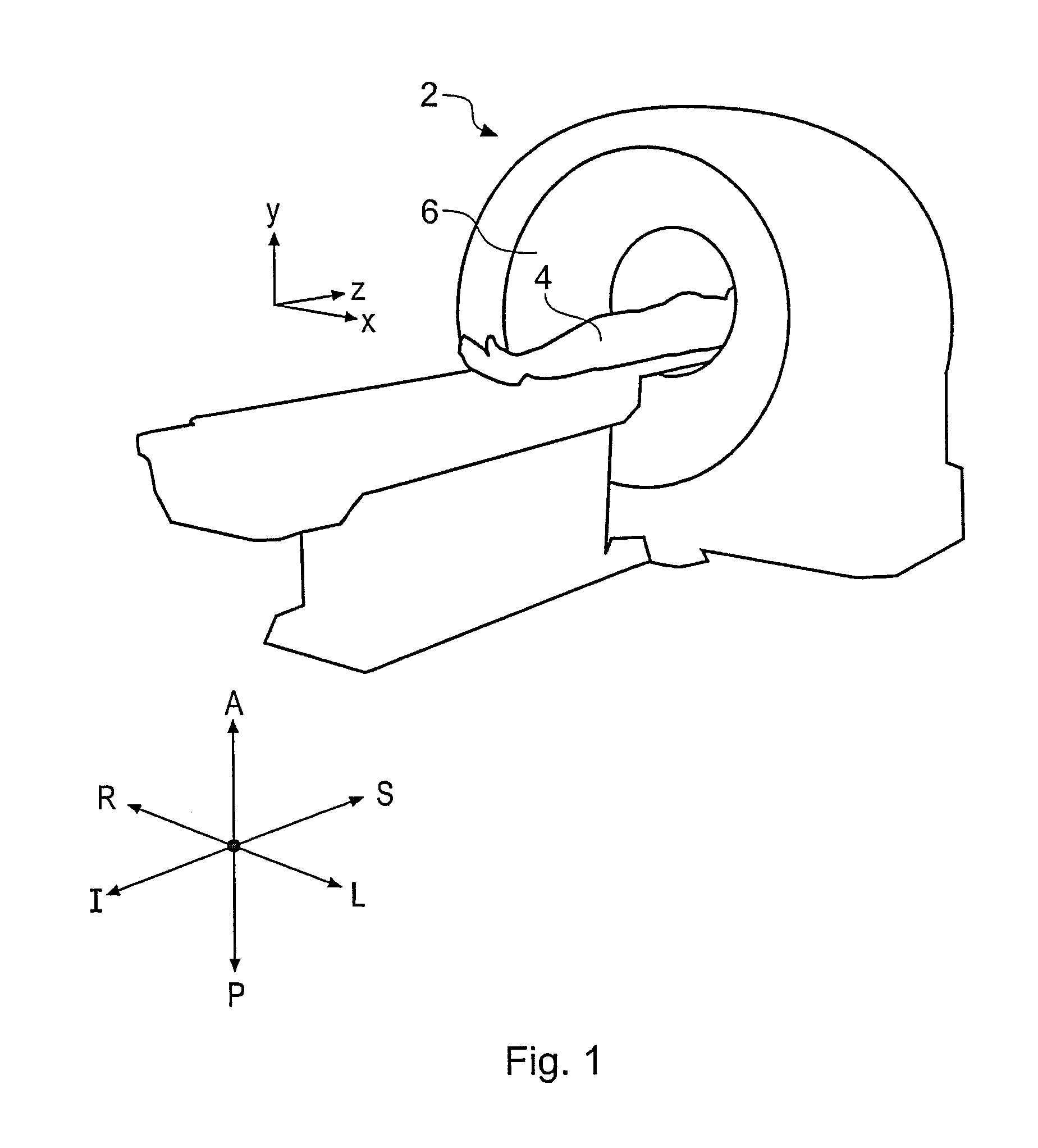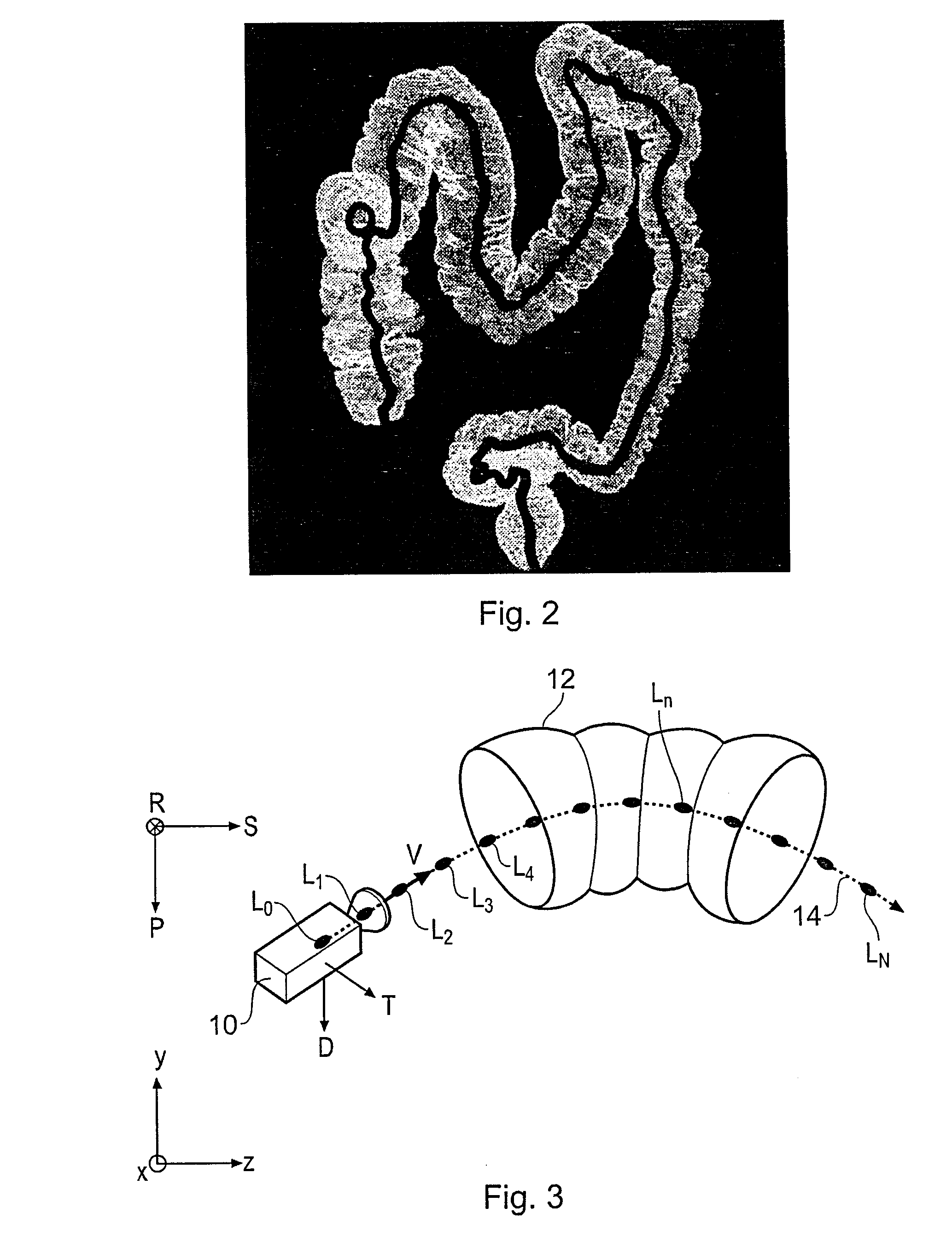[0015]Thus the method allows images to be rendered from locations along a virtual
endoscopy flight path (
navigation path) in a way that appears to tend to align the camera with an
artificial gravity direction. This helps to provide a user with a more easily interpretable, and less disorienting, virtual endoscopy experience. Furthermore, because the images tend to align with a direction that can be the same in different data sets, flythrough of different data sets representing the same lumen will tend to adopt the same
camera orientation when in the same parts of the lumen. This allows for easier comparison of virtual endoscopy flythroughs through different data sets since features which are attached to the lumen wall, e.g. polyps in a
virtual colonoscopy, will tend to appear in the same part of corresponding images in different flythroughs. This is because the
camera orientation is registered with respect to a selected direction with respect to patient orientation. Furthermore, by orienting the virtual camera in accordance with a rotation from the initial orientation towards the bias direction by a fractional amount of the offset angle which varies according to the initial orientation, a balance between providing an observer with a
perception of gravity, and maintaining a preferred view direction so far as the geometry of the lumen is concerned and avoiding potential
barrel rolling of the virtual camera can be provided.
[0019]In some embodiments, the fractional amount may vary between zero and unity if the offset angle is within a predetermined partial-rotation range. For example, in embodiments where the above-referred to predetermined full-rotation threshold and predetermined no-rotation threshold are employed, the predetermined partial-rotation range may run between these thresholds. Alternatively, the predetermined partial-rotation range may span all possible offset angles (0° to 180°). For example, the predetermined partial-rotation range may have lower boundary selected from the group consisting of 0°, 1°, 2°, 3°, 4°, 5°, 6°, 7°, 8°, 9°, 10°, 11°, 12°, 13°, 14° and 15° and an upper boundary selected from the group consisting of 15°, 20°, 25°, 30°, 35°, 40°, 45°, and 50°. The fractional amount may, for example, decrease linearly, or exponentially, with increasing offset angle within the predetermined partial-rotation range. By varying the fractional amount in this way, the user is provided with the
perception of an increasing
gravitational force as the camera gets closer to being aligned with the bias direction. This has been found to reduce user disorientation.
[0022]In cases where the fractional amount varies according to an angular separation between a predetermined direction in the data set and a view direction of the virtual camera for the initial orientation, the fractional amount may be zero if the angular separation is less than a predetermined no-rotation threshold. This helps to avoid alarming
barrel rolls that may otherwise occur as a flight path changes direction about the perceived vertical which is aligned with the predetermined direction (whether is heading “up” or “down”). The predetermined no-rotation threshold may be selected from the group consisting of 1°, 2°, 3°, 4°, 5°, 6°, 7°, 8°, 9°, 10°, 11°, 12°, 13°, 14°, 15°, 16°, 17°, 18°, 19° and 20° (it being understood that the angular separation may be measured from “up” or “down” along the predetermined direction).
[0023]Furthermore, the fractional amount may be unity if the angular separation is greater than a predetermined full-rotation threshold. For example, the predetermined full-rotation threshold may be selected from the group consisting of 15°, 20°, 25°, 30°, 35°, 40°, 45° and 50°. This ensures the full effects of the perceived virtual gravity can be provided when there is little risk of barrel roll because the flight path is significantly far from being aimed directly “up” or “down”.
[0024]In some embodiments, the fractional amount may vary between zero and unity if the angular separation is within a predetermined partial-rotation range. For example, in embodiments where the above-mentioned predetermined full-rotation threshold and predetermined no-rotation threshold for the angular separation are employed, the predetermined partial-rotation range may run between these thresholds. Alternatively, the predetermined partial-rotation range may span all possible angular separations, i.e., 0° to 90° (since angular separation can be measured from either “up” of “down” along the predetermined direction, it is only necessary to consider this range). For example, the predetermined partial-rotation range may have lower boundary selected from the group consisting of 0°, 1°, 2°, 3°, 4°, 5°, 6°, 7°, 8°, 9°, 10°, 11°, 12°, 13°, 14°, 15°, 16°, 17°, 18°, 19° and 20°, and an upper boundary selected from the group consisting of 15°, 20°, 25°, 30°, 35°, 40°, 45°, and 50°. The fractional amount may, for example, increase linearly, or exponentially, with increasing angular separation within the predetermined partial-rotation range. This has been found to assist
user orientation.
[0028]The method may also include determining a desired orientation for the virtual camera relative to the data set for the selected location based on the geometry of the lumen, determining a
relocation angle between the desired orientation of the virtual camera and a previous orientation of the virtual camera, and determining the initial orientation of the virtual camera to be the desired orientation if the
relocation angle is greater than a
relocation angle threshold, and otherwise maintaining the previous orientation as the initial orientation. This has been found to help increase the perceived smoothness of a flythrough. The relocation angle threshold may, for example, be selected from the group consisting of 1°, 2°, 3°, 4°, 5°, 6°, 7°, 8°, 9° and 10°.
 Login to View More
Login to View More  Login to View More
Login to View More 


